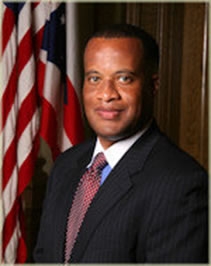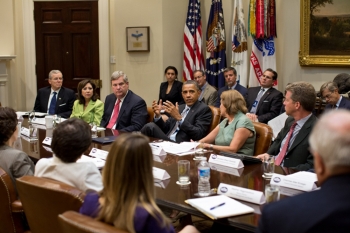Guess blog post by Jay Williams, Assistant
Secretary of Commerce for Economic Development
Shortly after
being sworn-in as Assistant Secretary of Commerce for Economic Development in
May, I traveled to Anchorage, Alaska on my first official trip. There, I participated
in the National Congress of the American Indians’ (NCAI) mid-year
conference entitled, “Claiming our Rights and Strengthening our Governance” where
I had the opportunity to meet with tribal leaders from across the country and
to participate in a focused discussion on the importance of developing modern
trust management systems and creating the conditions for economic growth on
tribal trust lands.
Building
on this engagement, I was honored to be asked to moderate the “Strengthening
Tribal Economies – Jobs, Energy, Housing, and Infrastructure” breakout session,
a vital component of the White House
Tribal Nations Conference that is taking place in Washington this week.
Joined
by colleagues representing a plethora of Federal agencies with involvement in
the White House Council on Native American Affairs - an interagency working
group brought together to tackle the issues that affect Indian Country - we
discussed the critical roles that each agency plays in helping build economic
and job opportunity in Indian Country. We also heard from tribal leaders on the
challenges and opportunities they face and broadened the dialogue about how the
Federal government can continue to support their local economic development
strategies.
The fact that my first official engagement as EDA Assistant
Secretary was with Tribal nations and that I was asked to moderate this
critical White House session is not coincidental.
Economic development creates the
conditions for economic growth and improved quality of life by expanding the
capacity of individuals, firms, and communities to maximize their talents and
skills to support innovation, lower transaction costs, and responsibly produce
and trade valuable goods and services.
For nearly 50 years, the U.S. Economic Development Administration has partnered with Tribal communities from coast to coast to promote
economic development in
Indian Country.
During the past five years, EDA has awarded
nearly $54 million in assistance to Indian tribes to create businesses, build
roads and other infrastructure, and develop their own economic development
strategies.
While EDA grants and other Federal
investments are removing economic barriers and attracting capital to Indian
country, we know there is more work to be done and look forward to a strong continued
partnership with our nation’s tribal communities to strengthen tribal
economies.
By
bringing so many government representatives and Tribal leaders together at the
White House Tribal Nation’s Conference, we aim to be more accessible to Indian Country.
























![Assistant Secretary Williams announces $1 million EDA investment to help build the Austin’s [re]Manufacturing Hub Eco-Industrial Park. (L-R): Austin Mayor Lee Leffingwell, Assistant Secretary Williams, U.S. Congressman Lloyd Doggett. Assistant Secretary Williams announces $1 million EDA investment to help build the Austin’s [re]Manufacturing Hub Eco-Industrial Park. (L-R): Austin Mayor Lee Leffingwell, Assistant Secretary Williams, U.S. Congressman Lloyd Doggett.](../../sites/default/files/imagecache/custom_crop_350x230/images/2014/july/jay-williams-austin.jpg)






















































